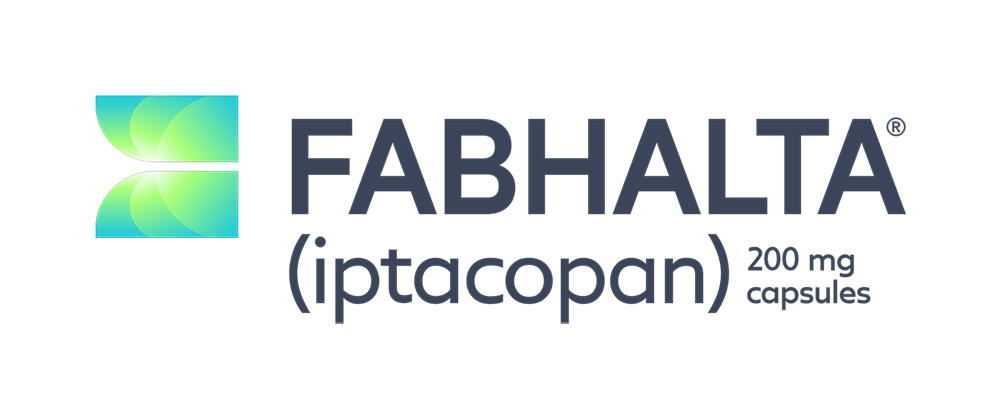Efficacy data for FABHALTA® (iptacopan)
IN ADULTS WITH C3G, TO REDUCE PROTEINURIA1
FABHALTA significantly reduced proteinuria vs placebo at Month 62
Click on image to enlarge.
At Month 6, the geometric mean UPCR ratio relative to baseline was 0.70 (95% CI: 0.57, 0.85) and 1.08 (95% CI: 0.88, 1.31) in the FABHALTA and placebo groups, respectively1
The treatment effect of FABHALTA on UPCR at Month 6 was generally consistent across subgroups, including age, sex, race, baseline disease characteristics (such as baseline proteinuria and eGFR levels), and use of immunosuppressive therapies.1
FABHALTA delivered a reduction in proteinuria at Month 6 that was maintained at Month 121,2
Click on image to enlarge.
After the initial 6-month treatment period, all patients received FABHALTA for an additional 6 months.1
In patients initially randomized to FABHALTA, the reduction in 24-hour UPCR seen at Month 6 was maintained at Month 12. In patients who switched from placebo to FABHALTA, the reduction in 24-hour UPCR from Month 6 to Month 12 was similar to the reduction seen in patients initially randomized to FABHALTA.1
In a supplemental analysis of geometric mean UPCR first morning void ratio relative to baseline at Month 62:
FABHALTA arm: 0.68 (95% CI: 0.52, 0.87)
Placebo arm: 1.00 (95% CI: 0.77, 1.31)
The relative reduction at Month 6 was 33% between FABHALTA and placebo
AS MEASURED BY COMPOSITE END POINT
FABHALTA-treated patients had 7-fold higher odds (P=.0166) of achieving a composite renal end point vs placebo-treated patients at Month 61
While more FABHALTA-treated patients (30%) compared to placebo (6%) achieved a ≥50% reduction in 24-hour UPCR compared to baseline, there was no difference between FABHALTA and placebo in the proportion of patients with stable or improved eGFR compared to baseline at Month 6 (90% in FABHALTA vs 89% in placebo)1
Composite renal end point was defined as:
A ≥50% reduction in 24-hour UPCR compared to baseline + stable or improved eGFR compared to baseline (≤15% reduction in eGFR)1
Click on image to enlarge.
Following the 6-month treatment period, all patients were treated with FABHALTA for an additional 6-month open-label period. Results from the open-label period are descriptive in nature. No statistical hypothesis testing was done. Data should be interpreted with caution, and no formal conclusions can be made.
At Month 12, composite renal end point was met by 44.1% of FABHALTA-treated patients and 24.0% of those who switched to FABHALTA from placebo2
≥50% proteinuria reduction2: 45.9% (FABHALTA) and 29.4% (FABHALTA switch)
Stable or improved eGFR2: 84.2% (FABHALTA) and 88.2% (FABHALTA switch)
A separate secondary end point analyzing the change in eGFR from baseline to Month 6 was studied.2
No statistically significant difference in eGFR was seen between FABHALTA and placebo at Month 6 (+1.3 mL/min/1.73 m2 with FABHALTA and -0.9 mL/min/1.73 m2 with placebo).2 Since the threshold for statistical significance was not met, any numerical difference could be due to chance
Results presented below are from the open-label period which are descriptive in nature. No statistical hypothesis testing was done. Data should be interpreted with caution, and no formal conclusions can be made.
Exploratory end point2: In patients initially randomized to FABHALTA, the mean change from baseline in eGFR at Month 12 was +0.44 mL/min/1.73 m2
Post hoc exploratory analysis:
Proportion of participants with different levels of proteinuria (24-hour UPCR)2
Click on image to enlarge.
Following the 6-month treatment period, all patients were treated with FABHALTA for an additional 6-month open-label period. Results from the open-label period are descriptive in nature. No statistical hypothesis testing was done. Data should be interpreted with caution, and no formal conclusions can be made.
The proportion of participants with different levels of proteinuria at Month 122:
FABHALTA: 23.7% (<1 g/g), 36.8% (1 to <3 g/g), 36.8% (≥3 g/g), 2.6% (missing)
FABHALTA SWITCH from placebo: 13.9% (<1 g/g), 52.8% (1 to <3 g/g), 27.8% (≥3 g/g), 5.6% (missing)
